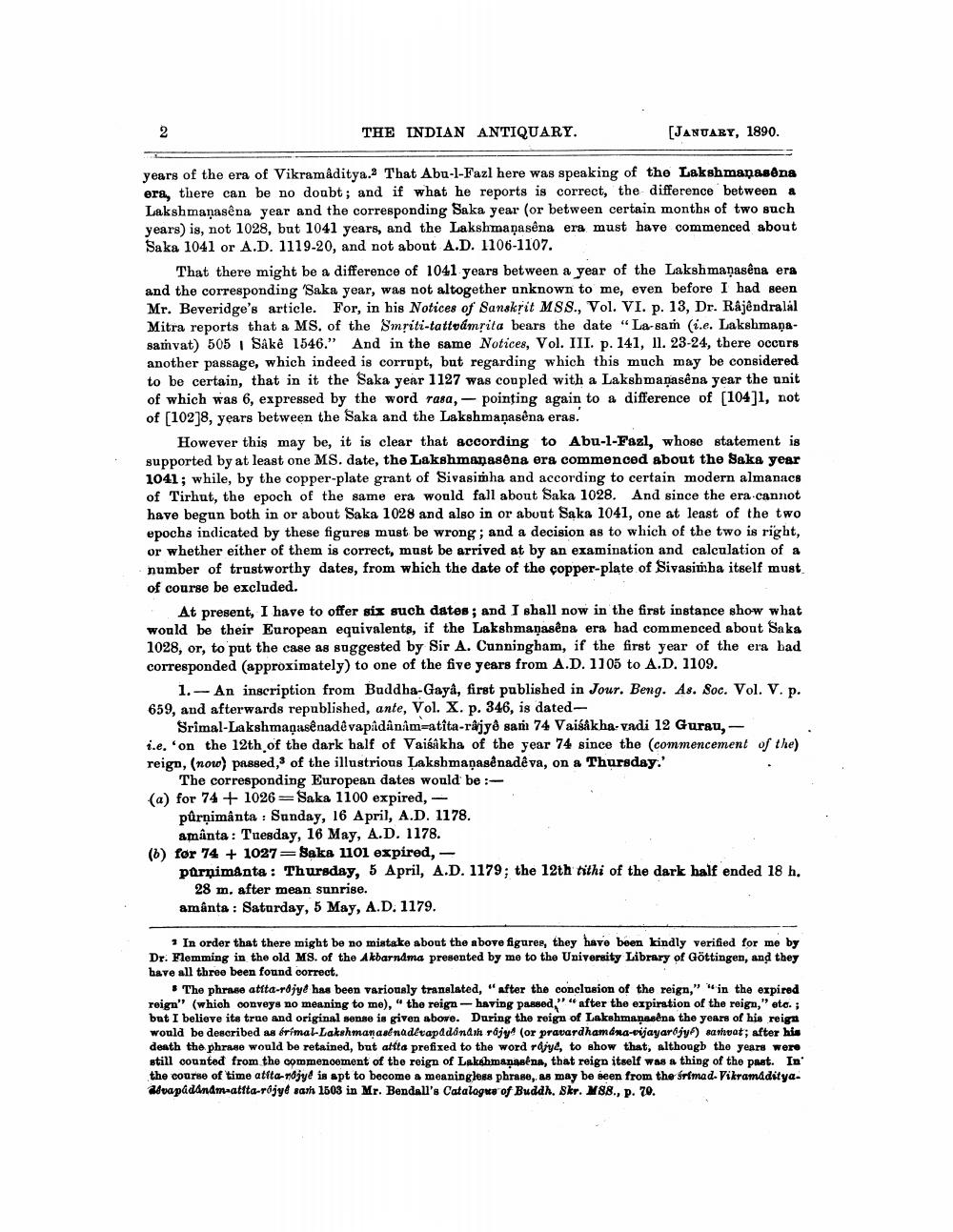Book Title: Indian Antiquary Vol 19 Author(s): John Faithfull Fleet, Richard Carnac Temple Publisher: Swati Publications View full book textPage 8
________________ THE INDIAN ANTIQUARY. [JANUARY, 1890. years of the era of Vikramaditya.? That Abu-l-Fazl here was speaking of the Lakshmanasena era, there can be no doubt; and if what he reports is correct, the difference between a Lakshmanasêna year and the corresponding Saka year (or between certain months of two such years) is, not 1028, but 1041 years, and the Lakshmaņasêna era must have commenced about Saka 1041 or A.D. 1119-20, and not about A.D. 1106-1107. That there might be a difference of 1041 years between a year of the Lakshmanasena era and the corresponding Saka year, was not altogether unknown to me, even before I had seen Mr. Beveridge's article. For, in his Notices of Sanskrit MSS., Vol. VI. p. 13, Dr. Rajendralal Mitra reports that a MS, of the Smriti-tattvamrita bears the date "La-sam (ie. Lakshmanasamvat) 505 Sakê 1546." And in the same Notices, Vol. III. p. 141, 11. 23-24, there occurs another passage, which indeed is corrupt, but regarding which this much may be considered to be certain, that in it the Saka year 1127 was coupled with a Lakshmaņasêna year the unit of which was 6, expressed by the word rasa, - pointing again to a difference of [104]1, not of [102]8, years between the Saka and the Lakshmaņasêna eras. However this may be, it is clear that according to Abu-l-Fazl, whose statement is supported by at least one MS. date, the Lakshmanasena era commenced about the Saka year 1041; while, by the copper-plate grant of Sivasimha and according to certain modern almanacs of Tirhut, the epoch of the same era would fall about Saka 1028. And since the era cannot have begun both in or about Saka 1028 and also in or abuut Saka 1041, one at least of the two epocha indicated by these figures must be wrong; and a decision as to which of the two is right, or whether either of them is correct, must be arrived at by an examination and calculation of a number of trustworthy dates, from which the date of the copper-plate of Sivasimha itself must of course be excluded. At present, I have to offer six such dates; and I shall now in the first instance show what would be their European equivalents, if the Lakshmaņasêna era had commenced about Saka 1028, or, to put the case as suggested by Sir A. Cunningham, if the first year of the era bad corresponded (approximately) to one of the five years from A.D. 1105 to A.D. 1109. 1.- An inscription from Buddha-Gayâ, first published in Jour. Beng. As. Soc. Vol. V. p. 659, and afterwards republished, ante, Vol. X. p. 346, is dated Srimal-Lakshmanusênadê vapadanam-atîta-rajyê san 74 Vaisakha-vadi 12 Gurau,i.e, on the 12th of the dark half of Vaisakha of the year 74 since the commencement of the) reign, (now) passed, of the illustrious Lakshmaņasênadêva, on a Thursday: The corresponding European dates would be :(a) for 74 + 1026=Saka 1100 expired, - půrnimânta : Sunday, 16 April, A.D. 1178. amanta: Tuesday, 16 May, A.D. 1178. (6) før 74 + 1027=Baka 1101 expired, - purnimanta: Thursday, 5 April, A.D. 1179; the 12th tithi of the dark half ended 18 h. 28 m. after mean sunrise. amânta : Saturday, 5 May, A.D. 1179. 1 In order that there might be no mistake about the above figures, they have been kindly verified for me by Dr. Flemming in the old MS. of the Akbarndma presented by me to the University Library of Göttingen, and they have all three been found correct. The phrase atita-rdjye has been variously translated, "After the conclusion of the reign," " in the expired reign" (which conveys no meaning to me)," the reign-having passed," "after the expiration of the reign," eto; but I believe its true and original sense is given above. During the reign of Lakshmanasena the years of his reign 8 érimal-Lakshmanasé nadltapddandih ragy! (or pravardhamana-vijayardjy) samvat; after his death the phrase would be retained, but atita prefixed to the word rdjye, to show that, although the years were still counted from the commencement of the reign of Lakshmanasena, that reign itself was a thing of the past. In the course of time atita-njye is spt to become a meaningless phrase, as may be seen from the Srimad. Vikramaditya. dévapádándm-atfta-rójyd sath 1503 in Mr. Bendall's Catalogua of Buddh, Skr. M88., p. 70.Page Navigation
1 ... 6 7 8 9 10 11 12 13 14 15 16 17 18 19 20 21 22 23 24 25 26 27 28 29 30 31 32 33 34 35 36 37 38 39 40 41 42 43 44 45 46 47 48 49 50 51 52 53 54 55 56 57 58 59 60 61 62 63 64 65 66 67 68 69 70 71 72 73 74 75 76 77 78 79 80 81 82 ... 510
